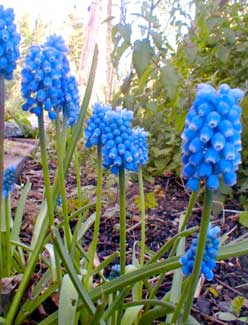
'Dark Eyes'
Armenian Grape Hyacinths
"Every flower is a soul blossoming in nature."
-Girard de Nerval,
1808-1855
"The eyes indicate the antiquity of the soul."
-Ralph Waldo Emerson,
1803-1882
1808-1855
1803-1882
'Dark Eyes' grape hyacinth has a fluffy cone of cobalt blue flowers. The lower florets of the cone have a fine lacy edging of pure white, the white aging to faint pinkish. The white rim or "eye" was something I had expected would give it considerable distinction when compared to other standard blue grape hyacinths.
But as it turns out, the eye does not develop until the flower is very mature; for the most part it looks identical to regular M. armeniacum & M. botryoides which themselves also occasionally possess the "eye" at maturity. Granny Artemis & I love grape hyacinths & don't mind duplication, & even look-alikes may bloom earlier or later to extend the presence of flowers for the genus. Still, in general, 'Dark Eyes' wouldn't be the one to add to a collection for reasons of differentness.
In full flower by approximately mid-March, the blooms are at first identical to many a standard blue. The photo above shows the drift of 'Dark Eyes' in late March, when the "eyes" are their most distinct. The "cap" of sterile-florets are slightly paler than the lower fertile florets.
There appears to be some confusion over this cultivar's species. We got ours to plant in autumn 2004 from the bulb distributor Simple Pleasures, who listed it as Muscari armeniacum. But that same year Bulbmeister & several others, especially in Germany, listed it as M. aucheri, on what authority I'm not aware. Simultaneously, Van Engelen Bulbs & John Scheepers & a few others gave it as a cross of M. neglectum with the little white-flowering M. pallens. By far the majority of catalogs hazard no guess as to its species.
Because the Royal Horticultural Society lists it provisionally as M. armeniacum, & because when in doubt I tend to rely on the RHS assessment, I go with M. armeniacum until better evidence is forthcoming. But I also respect the knowledge so evident from the company of John Scheepers, & do note that it appears the Royal Horticultural Society itself currently has some suspicion that M. neglectum x pallens may not be out of the question.
The confusion arises in part because they were found in nature, not bred in cultivation with good records as to how. They were collected by Janis Ruksan of Latvia, in the North Caucasus region in 1969. The so-called "Verin hybrids" from Ruksan include 'White Beauty' (white grapes with the lower ones tinged the faintest pink), 'Sky Blue" (an extremely pale blue), & 'Dark Eyes.'
The stiff grass appears in February arranged in a funnel like a badmitnton birdie. come early spring, flowers rise from the center of the circle of slim leaves to about eight inches tall, above six inch grassy blades.
'Dark Eyes' is ideal for partial-sun locations but also do quite well in considerable shade. The bulbs can be placed two inches apart, four inches deep, in autumn. Our dozen bulbs were planted in September in a semi-shady area along the sidewalk. Over time they should naturalize & spread into a considerable drift.
Their miscellaneous traits include deer-resistance, drought hardiness, good cut flowers, & attractive to pollinators.